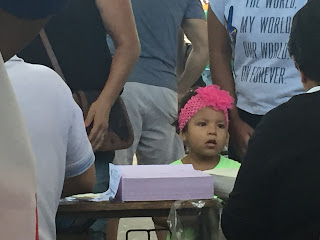Election Observing in El Salvador: Crayons and Paper
Salvadorans vote with paper ballots. One of the most important roles of the election observer is to keep an eye on those paper ballots.
The system is set up to be secure. The ballots arrive in the sealed box of voting supplies assigned to the voting table. The ballots are printed and glued on one side to form tablets of 600 - one ballot for each of the 600 voters assigned to each voting table. Prior to the start of voting, the table secretary counts the stacks of ballots to ensure that there are indeed 600 ballots in the tablet. For the 2018 election, the voter received 2 ballots - one for the national election and one for the local election.
 |
| Future voter peering over the tablets of pink and yellow ballots at one voting table. |
The light yellow paper was the ballot for deputies in the national election for deputies in the Legislative Assembly (similar to representatives in the US House of Representatives). Each of the fourteen departments (like states) in El Salvador has a different assembly ballot. The number of deputies assigned to each department is based on the population of the department. San Salvador is the largest department, and has 24 assigned deputies. Voters can vote a straight party ticket by marking one of the eight party flags at the top of the ballot. San Salvador voters could vote for 24 individual deputies from different parties. With 8 political parties represented, each with 24 candidates running for seats, plus 4 non-partisan candidates, the grand total of individual faces on the ballot was 196. Each ballot counts as one total vote. Cross-over voting results in fractional votes for candidates. As on the pink ballot, the voter casts his or her votes by making a mark with the black crayon over the party flag and/or faces.
 |
| San Salvador ballot for deputies and a box of crayons. Note the corner has been torn away on the bottom right in the photo. |
Once the polls close, the first step at the table is to put away the black crayons and the ink (used to mark the finger of each person who has voted). The next step is to count the unused ballots and to tear them in half so that they cannot be used in a fraudulent manner. The little corners are counted as a cross-check to make sure the number of used ballots plus the number of unused ballots adds up to 600.
 |
| Tearing unused ballots. |
The counts for each category were added up, and hopefully the total matched the number of corners from the little bag. At two of the voting tables at the school where I was an observer, the end count came to 601. Everything unused ballot and cast ballot needed to be recounted to make sure there had not been an extra ballot cast. In the end, all tables ended up with 600 ballots accounted for.
The paper and crayon method of voting is labor intensive and slow. Yet, it does provide clear visual evidence of the votes cast. And some of the messages on the nullified ballots were quite unique...but that is a story for another day.
This is the third in a series of blog posts about the 2018 elections in El Salvador. Unless otherwise noted, the photos in this story were taken by the author. Other stories in this series include:
Election Observing in El Salvador: The Voting Experience
Election Observing in El Salvador: Cardboard and Tape
 |
| Stacks of ballots being counted and sorted. |
 |
| A voting table president holds up a ballot after the election. |
This is the third in a series of blog posts about the 2018 elections in El Salvador. Unless otherwise noted, the photos in this story were taken by the author. Other stories in this series include:
Election Observing in El Salvador: The Voting Experience
Election Observing in El Salvador: Cardboard and Tape



Comments
Post a Comment